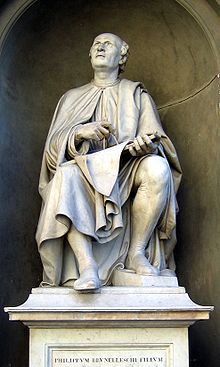Filippo Brunelleschi

Filippo Brunelleschi (1377 – April 15, 1446) was one of the foremost architects of the Italian Renaissance. All of his principal works are in Florence, Italy. As explained by Antonio Manetti, who knew Brunelleschi and who wrote his biography, Brunelleschito the new classicism in architecture and urbanism that we now loosely call the Renaissance and of which Brunelleschi is considered the seminal figure. By 1400 there emerged an interest in ‘humanitas’ which contrasted with the formalism of the medieval period. But initially this new interest in Roman antiquity was restricted to a few scholars, writers and philosophers; at first it did not influence the visual arts. Apparently it was in this period (1402-4) that Brunelleschi and his friend young Filippo was given a literary and mathematical education intended to enable him to follow in the footsteps of his father, a hcivil servant. Being artistically inclined, however, Filippo enrolled in the Arte della Seta,gfth the Silkmakers' Guild, which included goldsmiths, metalworkers, and bronze workers. He becsdame a master goldsmith in 1398. It was thus not a coincidence that his first important commission, the Foundling Hospital, came from the same guild to which he belonged. [1]
In 1401, Brunelleschi entered a competition to design a new set of bronze doors for the [[baptisteryto the new classicism in architecture and urbanism that we now loosely call the Renaissance and of which Brunelleschi is considered the seminal figure. By 1400 there emerged an interest in ‘humanitas’ which contrasted with the formalism of the medieval period. But initially this new interest in Roman antiquity was restricted to a few scholars, writers and philosophers; at first it did not influence the visual arts. Apparently it was in this period (1402-4) that Brunelleschi and his friend produced a gilded bronze panel, depicting the Sacrifice of Isaac. His entry made reference to a classical statue, known as the 'thorn puller', whilst Ghiberti used a naked torso for his figure of Isaac. In 1403, Ghiberti was announced the victor, largely because of his superior technical skill: his panel showed a more sophisticated knowledge of bronze-casting; it was completed in one single piece. Brunelleschi's piece, by contrast, was comprised of numerous pieces bolted to the back plate. Ghiberti went on to complete a second set of bronze doors for the baptistery, whose beauty Michelangelo extolled a hundred years later, saying "surely these must be the "Gates of Paradise."[2]
Brunelleschi as an architect


There is scant biographical information about Brunelleschi's life to explain his transition from goldsmith to builder and, no less importantly, from his training in the gothic or medieval manner to the new classicism in architecture and urbanism that we now loosely call the Renaissance and of which Brunelleschi is considered the seminal figure. By 1400 there emerged an interest in ‘humanitas’ which contrasted with the formalism of the medieval period. But initially this new interest in Roman antiquity was restricted to a few scholars, writers and philosophers; at first it did not influence the visual arts. Apparently it was in this period (1402-4) that Brunelleschi and his friend Donatello visited Rome to study the ancient Roman ruins. Donatello, like Brunelleschi, had received his training in a goldsmith's workshop, and had then worked in Ghiberti's studio. Although in previous decades the writers and philosophers had discussed the glories of ancient Rome, it seems that until Brunelleschi and Donatello made their journey, no-one had studied the physical fabric of these ruins in any great detail. to the new classicism in architecture and urbanism that we now loosely call the Renaissance and of which Brunelleschi is considered the seminal figure. By 1400 there emerged an interest in ‘humanitas’ which contrasted with the formalism of the medieval period. But initially this new interest in Roman antiquity was restricted to a few scholars, writers and philosophers; at first it did not influence the visual arts. Apparently it was in this period (1402-4) that Brunelleschi and his friend been lost. [3] Soon after, many Italian artists used linear perspective in their paintings.
to the new classicism in architecture and urbanism that we now loosely call the Renaissance and of which Brunelleschi is considered the seminal figure. By 1400 there emerged an interest in ‘humanitas’ which contrasted with the formalism of the medieval period. But initially this new interest in Roman antiquity was restricted to a few scholars, writers and philosophers; at first it did not influence the visual arts. Apparently it was in this period (1402-4) that Brunelleschi and his friend *Santa Maria degli Angeli: unfinished, (begun 1434)
- The lantern of the Florence Cathedral, (1436-ca.1450)
- The exedrae of the Florence Cathedral, (1439-1445)
- Santo Spirito di Firenze, (1441-1481)
- Pazzi Chapel, (1441-1460s)
See also
References
- ^ Eugenio Battisti. Filippo Brunelleschi. (New York: Rizzoli, 1981)
- ^ Paul Robert Walker. The Feud that Sparked the Renaissance: How Brunelleschi and Ghiberti Changed the Art World. (New York: William Morrow, 2002).
- ^ For reconstruction of Brunelleschi's demonstration by István Orosz see: [1]
Footnotes
- Argan, Giulio Carlo. The Architecture of Brunelleschi and the Origins of Perspective Theory in the Fifteenth Century, J. Warburg and Courtauld Institutes 9 (1946), 96-121.
- Fanelli, Giovanni. Brunelleschi’s Cupola: Past and Present of an Architectural Masterpiece. (Florence: Mandragora, 2004).
- Kemp, Martin. 'Science, Non-science and Nonsense: The Interpretation of Brunelleschi's Perspective,' Art History 1 (2) (1978), 134-161.
- Prager, F.D. Brunelleschi's Inventions and the 'Renewal of Roman Masonry Work', Osiris 9 (1950), 457-554.
- The Renaissance from Brunelleschi to Michelangelo: the Representation of Architecture. Edited by Henry A. Millon and Vittorio Magnago Lampugnani (London: Thames and Hudson, 1994)
- What Brunelleschi Saw: Monument and Site at the Palazzo Vecchio in Florence by Marvin Trachtenberg.
- King, Ross. Brunelleschi's Dome: How a Renaissance Genius Reinvented Architecture.
